PICK OF THE MONTH
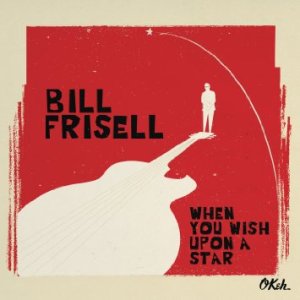 Bill Frisell
Bill Frisell
When You Wish Upon a Star
Sony/Okeh
88875142212
Guitarist and composer Bill Frisell has had a longstanding love affair with classic American film music–he even once went on tour playing accompaniments to silent Buster Keaton films. On his latest album he draws on a wide variety of film and TV music material including selections from the soundtracks to Psycho, Bonanza, The Godfather, and To Kill a Mockingbird. His arrangements are idiosyncratic, to say the least, and feature his longstanding collaborators Eyvind Kang (viola), Thomas Morgan (bass), Rudy Royston (drums), and singer Petra Haden. Don’t let the album title mislead you: there are definitely moments of lighthearted charm here, but the more dominant mode is pretty dark and contemplative, and there are moments of genuine abstraction and abrasive skronk as well. But it’s Frisell’s particular genius to be able to be equally convincing whether delivering aggressive distortion or heartbreakingly gentle lyricism, and his bone-deep love of this music never stops shining through. Bill Frisell is one of the great treasures of American music, and this album demonstrates why.
CLASSICAL
 Franz Schubert
Franz Schubert
String Quintet op. 163 (reissue)
Arcanto Quartet; Olivier Marron
Harmonia Mundi
HMC 902106
Schubert’s quintet for strings (scored for two violins, viola, and two cellos) was one of his last compositions, completed only months before his untimely death in 1828. And even among his many yearningly Romantic works, it is one of the most emotionally intense. On this performance (using modern instruments), the Arcanto Quartet plays with tremendous skill and sensitivity, though at several points I found myself feeling oddly as if they were portraying someone else’s passion rather than feeling and expressing it themselves. On balance, though, this is a very enjoyable recording.
 Steve Reich
Steve Reich
Third Coast Percussion | Steve Reich
Third Coast Percussion
Cedille (dist. Naxos)
CDR 90000 161
Rick’s Pick
This is a very fine overview of pieces by American composer Steve Reich, presenting works that span 40 years of his career. The program features Mallet Quartet (2009), Sextet (1985), Nagoya Marimbas (1994), and the delightful Music for Pieces of Wood (1973). The Third Coast Percussion ensemble performs all of them with both skill and evident enjoyment, particularly the last piece; Sextet has never been my favorite Reich piece (it feels weirdly grumpy to me somehow), but the marimba compositions are ripplingly gorgeous and the whole album is very strongly recommended to all collections, even those that don’t normally focus on classical music.
 Various Composers
Various Composers
Mersenne’s Clavichord: Keyboard Music in 16th- and 17th-century France
Terence Charlston
Divine Art (dist. Naxos)
dda 25134
I confess that I’m a sucker for the clavichord. I love it the way you might love a three-legged dog or a mangy but charming cat. The clavichord was too small and quiet for use outside of small rooms or in ensembles, and although it utilized a hammer action it sounded more like a harpsichord than a fortepiano–though a harpsichord with much less sustain. Its sound is limited and idiosyncratic but definitely charming, and on this collection of keyboard works by the likes of Antoine de Févin, Louis Couperin, and Nicolas Gigault clavichordist Terence Charlston uses the instrument’s radically limited expressive range to full effect. Keyboard programs in particular will greatly benefit from access to this disc.
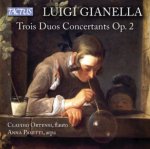 Luigi Gianella
Luigi Gianella
Trois Duos Concertants, Op. 2
Claudio Ortensi; Anna Pasetti
Tactus (dist. Naxos)
TC 770702
Rick’s Pick
What is it about the combination of flute and harp that inspires so many composers to write such amazing music? And how is it that this wonderful set of three flute-and-harp duets managed to stay hidden from the world for 200 years? The nearly complete obscurity of their composer himself is the most obvious answer, of course, but whatever the explanation, this world-premiere recording is a very welcome development, and the playing by flutist Claudio Ortensi and harpist Anna Pasetti is flawless. The music itself is as graceful and charming as one would expect of chamber music of the high-classical period. Very highly recommended to all classical collections.
 Various Composers
Various Composers
Lullabies for Mila (compilation)
Allesio Bax
Signum Classics (dist. Naxos)
SIGCD439
This album is presented by world-acclaimed pianist Alessio Bax as “a little gift” from him to his toddler daughter, who has been in the thick of his musical life since birth (and in that of his wife Lucille Chung, who is herself a world-class pianist). It features quiet and gentle pieces that have proved to be her favorites; many, including Bach’s “Sheep May Safely Graze” and the allegretto section from Beethoven’s “Moonlight” sonata, will be familiar to adult listeners, and all of course are characterized by a sense of warmth and comfort. It’s hard to imagine any toddler–or adult–not being soothed both by the selections and by Bax’s exquisite interpretations. (Note that all but one of the tracks on this album are drawn from previously-released recordings.)
 Chas Smith
Chas Smith
Twilight of the Dreamboats
Cold Blue Music
CB0045
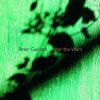 Peter Garland
Peter Garland
After the Wars
Sarah Cahill
Cold Blue Music
CB0044
 Michael Byron
Michael Byron
In the Village of Hope
Tasha Smith Godínez
Cold Blue Music
CB0043
In the pop music world, the concept of the “single” has a long history; in the classical world, it hasn’t really had any obvious application until fairly recently. The Cold Blue Music label is experimenting with this idea by releasing a series of single-work, 20-minute-long budget-line recordings featuring works by young composers. The three presented here are all very different from each other: After the Wars is a highly impressionistic, nearly programmatic four-movement piano suite, each movement of which is based on a Chinese poem or a Japanese haiku. In the Village of Hope is an attractive but ultimately rather exhausting piece for solo harp that manages to sound harmonically static while changing keys seven times–I’m still not sure how the composer did that. The playing is exemplary. Chas Smith’s Twilight of the Dreamboats is very different, a soundscape work that evolves slowly and is realized using purpose-built metal sound sculptures and slide guitars. All three are well worth hearing.
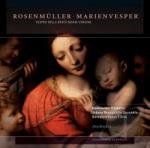 Johann Rosenmüller
Johann Rosenmüller
Marienvesper (2 discs)
Knabenchor Hannover; Johann Rosenmüller Ensemble; Barockorchester L’Arco / Jörg Breiding
Rondeau Production (dist. Naxos)
ROP701920
Although he influenced both Bach and Telemann, we know very little about Johann Rosenmüller’s life apart from what can be gleaned from the employment rosters of churches in Leipzig and Venice (including the famous cathedral of St. Mark, where he was apparently a trombone player). But the influence of the Venetian school on Rosenmüller’s music is very clear here, with this sumptuous set of compositions for a Marian vespers service. Comparisons with similar works by Monteverdi and Cavalli come immediately to mind, and frankly, Rosenmüller’s stands up very nicely against them. Recommended to all classical collections.
 Stefan Wolpe
Stefan Wolpe
Music for Violin and Piano (1924-1966)
Movses Pogossian; Susan Grace; Varty Manouelian
Bridge (dist. Albany)
9452
One of the things that made Stefan Wolpe such an interesting composer was the tension between his politics (as a Communist, he believed that music should be a straightforward reflection of human experience and should further revolutionary aims) and his inclination towards formalism and abstraction. As a result, his music sounds unlike that of any other 20th-century modernist, and on this very fine album the three featured instrumentalists tease all of the contradictions, tensions, and pleasures of this music–all of which are significant–out into the open with sympathy and virtuosity. Highly recommended.
JAZZ
 Pacific Harp Project
Pacific Harp Project
Pacific Harp Project
Megan Bledsoe Ward
No cat. no.
Rick’s Pick
I’m fairly open-minded about instrumental configurations when it comes to jazz, but having had a sonically traumatic experience with a jazz bassoonist some years ago, I’m still a bit wary when it comes to jazz for traditionally classical instruments (except violin). So I approached this album of harp-vibes-bass-drums compositions with some trepidation, but was immediately won over: first of all, harpist and bandleader Megan Bledsoe Ward has a solid grasp of jazz idiom–she’s not a dabbler or a dilletante. Second of all, this quartet swings powerfully and Ward herself writes beautiful melodies. Third, when she ventures into the very dangerous territory of arranging classical pieces in a jazz style, she comes out the other side not just unscathed but triumphant. Highly recommended to all collections.
 Ken Peplowski
Ken Peplowski
Enrapture
Capri
74141-2
Rick’s Pick
Another Ken Peplowski album, another enthusiastic recommendation in CD HotList: I truly apologize if the pattern is becoming tiresome, but it’s not my fault–blame it on Peplowski and his seemingly bottomless well of energy, musicianship, and open-hearted swing. His latest triumph is a quartet date that ranges far and wide in its pursuit of material, from a Duke Ellington deep cut (“The Flaming Sword,” remember that one? No?) to Peter Erskine’s “Twelve” and the Barry Manilow/Johnny Mercer tune “When October Goes.” As always, Peplowski makes both the clarinet and the tenor sax sing with equal warmth, and his accompanying piano trio supports him brilliantly. A must for all jazz collections.
 Julian Lage
Julian Lage
Arclight
Mack Avenue
MAC1107
The Fender Telecaster is a guitar that attracts disciples–people who are drawn to it by its unique tone and silky playability. Usually, Tele lovers tend to be country pickers and tend to explore its twanginess. But Julian Lage (who normally plays acoustic guitar) explores every nook and cranny of the instrument’s timbral possibilities on this, his first electric recording, and the result is a wildly varied program of straight-ahead jazz, Western swing, experimental improvisation, funk, and music that can’t really be categorized very well. He’s accompanied brilliantly by bassist Scott Colley and drummer Kenny Wollesen, and the only thing that stops this album from getting an enthusiastic <em>Rick’s Pick</em> is that it’s only 37 minutes long.
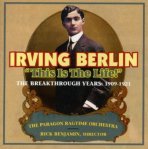 Paragon Ragtime Orchestra
Paragon Ragtime Orchestra
Irving Berlin: “This Is the Life!”
New World (dist. Albany)
80773-2
Further subtitled “The Breakthrough Years: 1909-1921,” this disc collects world-premiere recordings of period orchestrations of early songs and dance pieces by one of America’s greatest vaudeville and musical-theater talents. A variety of male and female soloists perform songs like “Alexander’s Ragtime Band’ and “A Pretty Girl Is Like a Melody,” but for me the highlights are the instrumental pieces; Berlin and his staff wrote great arrangements for these tunes and they’re worth close attention. The Paragon Ragtime Orchestra is an exceptional ensemble, and it performs these charming pieces with affection and verve.
 Bruce Torff
Bruce Torff
Down the Line
Summit (dist. Allegro)
DCD 672
Pianist/composer Bruce Torff has an unusual talent: the ability to write distinctly modern jazz that makes no compromises in terms of harmonic and melodic complexity, but that is at all times completely accessible. This is not a minor thing. Listen to the title track of his second album as a leader, and notice how strange the melody is and yet how easy it is to listen to, and contemplate how rare it is for a jazz guy to accomplish that. The whole album works that way, which is very impressive. It’s also worth noting that this album includes the last recordings by the great trumpter Lew Soloff, who died only days after the sessions were finished. Recommended to all jazz collections.
 Stan Getz
Stan Getz
Moments in Time
Resonance
HCD-2020

Stan Getz & João Gilberto
Getz/Gilberto ’76
Resonance
HCD-2021
During a week-long engagement at the Keystone Korner in San Francisco in 1976, saxophone legend Stan Getz led a quartet that included pianist Joanne Brackeen, bassist Clint Houston, and drummer Billy Hart. On one of those evenings the group was joined by Brazilian singer/songwriter João Gilberto. These two discs contain previously-unreleased recordings from those nights and are sure to please fans of Getz’s straight jazz work from his mid-to-late-period and also of his very popular bossa nova stuff, of which some of his most successful recordings had been with Gilberto in the mid-1960s. His playing is strong on both of these albums, and although the recorded sound is sometimes a little less than ideal it is never distractingly poor. Brackeen’s piano is a particular delight on both albums.
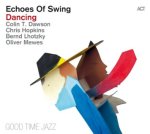 Echoes of Swing
Echoes of Swing
Dancing
ACT (dist. Allegro)
9103-2
Rick’s Pick
For about 20 years now, the German quartet Echoes of Swing has been celebrating (and sometimes gently subverting) the traditions of pre-bop jazz. They’re not revivalists, really–it’s more that they see no reason not to treat trad and swing-era jazz as a living and breathing musical genre. That fact may explain the unusual profusion of original compositions on this, the group’s eighth album. As is usually the case, the program includes both instrumental and vocal selections, and this time out the highlights include a wonderful tribute to Willie “The Lion” Smith written by pianist Bernd Lhotsky and a very fine rendition of Cole Porter’s “Dream Dancing” sung (in impeccable period style) by trumpeter Colin Dawson. This whole album is a joy.
COUNTRY/FOLK
 Solas
Solas
All These Years
THL
THL002
Most bands, when contemplating a 20-year retrospective album, will usually end up putting together a “greatest hits” collection. But the superstar Irish neo-trad group Solas took a different tack: they recorded an album of all-new material, inviting everyone who has ever been a member of the band to participate. That adds up to a pretty impressive lineup, one that includes guitarists John Doyle and Donal Clancy and singers Deirdre Scanlan and Karan Casey, among many others. The result is an album rich in tradition but forward-looking as well, on which traditional songs like “Willie Moore” and “Standing on the Shore” rub shoulders with excellent original compositions. This band’s many fans will not be disappointed.
 Ralph Stanley & The Clinch Mountain Boys
Ralph Stanley & The Clinch Mountain Boys
The Complete Jessup Recordings Plus! (compilation; 2 discs)
Real Gone Music
RGM-0429
In the early 1970s, it was not yet clear that hardcore traditional bluegrass was going to survive; audiences were dwindling and some of the younger musicians were experimenting with a more progressive take on the sound. But Ralph Stanley had no interest in modernizing his style, and when he heard the teenaged duo of Keith Whitley and Ricky Skaggs “singing Stanley Brothers music better than the Stanley Brothers,” it had to be an encouraging moment for him. He provided encouragement in turn, hiring Whitley and Skaggs into the Clinch Mountain Boys and making several albums with them. This two-disc set brings together the content of three albums that the resulting group made for the Jessup label between 1971 and 1973: one featured Whitley and Skaggs backed by the Clinch Mountain Boys, without Ralph Stanley; the other two were titled Sing Michigan Bluegrass and Gospel Echoes of the Stanley Brothers. The gospel material is the most powerful here, but all of it is well worth hearing and should find a place in any country or folk collection.
 Seraphic Fire
Seraphic Fire
Steal Away: The African American Concert Spiritual
Seraphic Fire Media
No cat. no.
I confess to having something of a love-hate relationship with concert spirituals. At their best, they are thrilling arrangements that bring new power to songs that are already affecting and poignant; at their worst, they sound awkward and mawkish (or even racist). In his liner notes to this collection, Seraphic Fire’s conductor Patrick Dupré Quigley explains how the group settled on particular questions of diction and pronunciation in order to “respect tradition without spilling over into caricature,” and I find the result to be quite effective. The program includes arrangements by John Work, Jester Hairston, Harry Burleigh, and Quigley himself, among others, and the performances nicely balance elegance, passion, and devotional intensity. Quigley’s own arrangements are especially well done–his setting of “Steal Away” may move you to tears.
 Jeb Loy Nichols
Jeb Loy Nichols
Longtime Traveller (2 discs)
On-U Sound (dist. Redeye)
ONUCD130
Rick’s Pick
Remember that reggae album that Willie Nelson did some years back, called Countryman? And remember how it kind of sucked? The problem, it turns out, is that you need more than an affinity for weed to make a great country/reggae fusion album. Willie should try it again, after taking a lesson from Jeb Loy Nichols: first of all, you need rhythms of elephantine weight, preferably played by Dub Syndicate; second of all, you need a producer like Adrian Sherwood. Most importantly, though, it helps to be a singer who kind of sounds like Bim Sherman and who writes lyrics that are long on lonely heartbreak and short on clever wordplay–the kind of singer, in other words, who doesn’t sound like he’s making a novelty move. Jeb Loy Nichols absolutely kills it here, and Sherwood wisely avoids any dubwise excess. (Though I do kind of wish the alternate mixes were dub versions. And I don’t understand why this is a two-disc set, since there’s only about 79 minutes of music here in total.) Longtime Traveller narrowly missed being Pick of the Month, and is a must for all collections.
 Laurie Lewis & The Right Hands
Laurie Lewis & The Right Hands
The Hazel & Alice Sessions
Spruce and Maple Music
SMM 1013
Rick’s Pick
No one has done more to preserve the legacy of bluegrass pioneers Hazel Dickens and Alice Gerrard than Laurie Lewis. Dickens and Gerrard were among the first women to sing bluegrass in much the same way that men like Bill Monroe and Ralph Stanley did: hard-edged and gritty, serious rather than cute, and often with a slyly feminist subtext. On this album Lewis and her band deliver an excellent set of songs written by or associated with Gerrard and Dickens, including classic numbers like “Walking in My Sleep” and “I Hear a Sweet Voice Calling.” It’s the Gerrard and Dickens originals that really stand out here, though, particularly the deeply affecting “Won’t You Come and Sing for Me?”. And if that second voice on “Pretty Bird” sounds like Linda Ronstadt, it’s because that’s who it is. Excellent.
ROCK/POP
 James Hunter Six
James Hunter Six
Hold On!
Daptone (dist. Redeye)
DAP-040
While straight genre-revival projects often leave me cold, I’ve been a big fan of English singer/songwriter’s James Hunter’s unapologetic 1960s R&B formalism ever since I heard People Gonna Talk ten years ago. On his first album for the Daptone label (talk about a match made in heaven), it’s clear that two things have happened, one of them sad and one happy: sadly, Hunter is no longer dabbling in the ska and bluebeat sounds that were a hallmark of his earlier work. Happily, he’s now consistently singing on pitch, which matters a lot. Great songs, great singing, an absolutely airtight band, vintage R&B grooves the likes of which we haven’t heard since Sam Cooke died–this is wonderful. (And for those of you who really care about verisimilitude, it’s recorded in mono.)
 Paul Carrack
Paul Carrack
Soul Shadows
Carrack-UK
PCARCD26
If you’d like to hark back to a more recent version of R&B, then check out the latest from Paul Carrack (also a Brit, incidentally), who has been keeping the soul torch alive since the early 1980s. Remember the Squeeze hit “Tempted”? That was Carrack on vocals, and his subsequent solo work has been just as good. On his latest solo album he departs not at all from his usual template: lushly arranged, smooth-but-slightly-gritty soul-pop of exquisite craftsmanship. Now in his mid-60s, he still has a voice that most 25-year-olds would kill for, and he still writes fantastic melodies. Strongly recommended to all pop collections.
 Ra Ra Riot
Ra Ra Riot
Need Your Light
Barsuk (dist. Redeye)
bark160
It seems like an awful lot of pop music these days is kind of quirky, kind of electro but with prominent guitars, maybe a little pretentious but usually very hooky. And as for me, I can take a lot of pretentiousness if it comes with good hooks. Life is short and mine’s getting shorter, and I’m listening to pop music for pleasure, not for self-improvement. That’s all by way of saying that this quirky, slightly pretentious, shiny/crunchy, and blissfully hook-filled album from Ra Ra Riot is really great. It puts me in mind of a slightly less self-consciously intellectual Vampire Weekend. I’ll be listening to it over and over, and I bet my teenage son will love it too.
 Game Theory
Game Theory
Lolita Nation (deluxe reissue; 2 discs)
Omnivore
OVCD-136
The Omnivore label’s exhaustive Game Theory reissue compaign continues apace with this lavish treatment of what most fans of 1980s alt-rock will probably agree is the band’s best album. It’s also their weirdest, with long and nonsensical song titles and short and nonsensical instrumental snippets in between the real songs. But the real songs are real indeed, and even when they have disjointed and experimental surfaces the carefully crafted pop music underneath always shines through. This reissue includes an additional disc of alternate takes, demos, live versions, and covers of songs by the likes of Elvis Costello, David Bowie, and Joy Division. Recommended to all pop collections.
 Ricardo Donoso
Ricardo Donoso
Symmetry (reissue; 3 discs)
Denovali (dist. NAIL)
DEN227
This limited-edition box contains three previously-released albums by ambient composer Ricardo Donoso: Progress Chance (2011), Assimilating the Shadow (2012), and As Iron Sharpens Iron, One Verse Sharpens Another (2013). All of them feature dark, rather minimalist, and often slightly grouchy-sounding sound sculptures, some of them built on regular rhythms and coming close to industrial levels of beat specificity, and others much more abstract. All of it is quite beautiful, and Donoso is a talent very much worth keeping an eye on. If you try to order and find that the available stock is sold out, look for some of his other work: I particularly recommend the dark and foreboding Saravá Exu.
 Dressy Bessy
Dressy Bessy
Kingsized
Yep Roc (dist. Redeye)
YEP-2458
There was a time when music like this–scrappy, noisy, superficially sloppy but secretly well-crafted–would have been classified as “punk rock.” These days the word “punk” is very often applied to what would, in the old days, have been called “power pop” (cf. Green Day, Bad Religion) and there’s no longer a good word for what Dressy Bessy does. So be it; doesn’t matter. Here’s what makes them worth your while: not only do they write melodic hooks, but they write textural and rhetorical ones as well–I bet you’ll chant along with the “I bet she would!” on “Lady Liberty” just as readily as you’ll hum along with any of the equally compelling tunes on this scrappy, noisy, deceptively sloppy-sounding but deeply well-crafted album.
WORLD/ETHNIC
 Aziza Brahim
Aziza Brahim
Abbar el Hamada
Glitterbeat
GBCD 031
Aziza Brahim hails from the Western Sahara, but has lived in Europe as a refugee for most of her life and has become one of the most important and influential musical voices of the Saharawi diasporan protest movement. If your Arabic is rusty the political content of her second album may be tough to follow, but there’s no question about the music: largely acoustic, alternately brisk and mournful, and driven by Brahim’s towering voice, it draws deeply on both the traditions of her homeland and on the rhythms of her adopted home in Spain. Recommended to all world music collections, particular those with a collecting interest in protest music.
 Various Artists
Various Artists
Slåtter på Vandring: Travellers’ Fiddle Tunes from Norway (2 discs)
Etnisk Musikklub (dist. Albany)
EM 9
The tradition of the “traveling fiddler” is quite important in Norway: these were itinerant musicians who went from village to village playing unaccompanied tunes for dances, either on the Hardanger or the conventional fiddle. This two-disc set brings together recordings by five acclaimed traveling fiddlers. To American ears many of these tunes will sound dry and astringent, but keep listening and the melodies start to stand out a bit more clearly–and there’s no denying these players’ rhythmic power. There are also good and informative liner notes in both English and Norwegian.
 Count Ossie and the Mystic Revelation of Rastafari
Count Ossie and the Mystic Revelation of Rastafari
Tales of Mozambique (reissue)
Soul Jazz (dist. Redeye)
SJR CD325
Despite the ensemble’s name and song titles like “Nigerian Reggae” and “Rasta Reggae,” this is by no means a reggae album. Count Ossie is one of the pioneers of Nyabinghi drumming and chanting, and that is what’s showcased on this classic album from 1975. This is music that is usually presented in the context of a “reasoning” session in which the principles of Rastafarianism are publicly discussed and debated before the drumming and singing begin. True to form, the Soul Jazz label has given this album a loving reissue treatment with extensive liner notes and a couple of bonus tracks.
 Lakou Mizik
Lakou Mizik
Wa Di Yo
Cumbancha
CMB-CD-38
This ensemble was created in the wake of the earthquake that devastated Haiti in 2010. It consists of older musicians and younger ones from a variety of musical and faith traditions: a Christian church singer, a vodou drummer, a singer-songwriter, a poet who survived a ferry disaster by floating on the back of a cow carcass for three days, etc. This multiplicity of musical and experiential backgrounds leads to just what you’d expect: an album that is a crazy quilt of Haitian musical styles, from contemplative acoustic balladry to ecstatic chanting and throbbing compas. It’s fun but also moving.
 Taj Weekes & Adowa
Taj Weekes & Adowa
Love, Herb & Reggae
Jatta
No cat. no.
Rick’s Pick
Don’t be fooled by the soft high-tenor voice, the sweet melodicism, and the gently insistent rhythms: Taj Weekes is trying to change the world, and he’s not only willing to offend Babylon in the process, but he’s also fully prepared to get crosswise with hardcore Rastafarians, who, if they listen closely to the anti-homophobia ballad “Here I Stand” (presented here in two versions) will probably boycott his concerts if not attack him physically. Everything else is more conventional roots-and-culture reggae, from the “weed is not a drug” messaging (notice the sly album title, an artful juxtaposition with “sex and drugs and rock’n’roll”), the multiple calls to rebellion, and the exhortation to the youth to stop shooting each other. And by the way, those gently insistent rhythms absolutely kill. With love, of course.